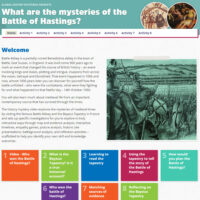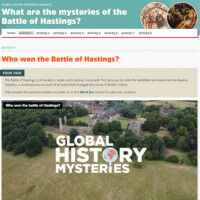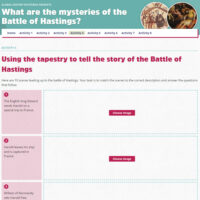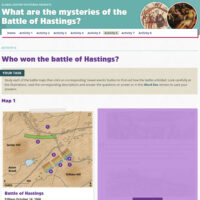Battle Abbey is a partially ruined Benedictine abbey in the town of Battle, East Sussex, in England. It was built some 900 years ago to mark an event that changed the course of British history – an event involving kings and dukes, plotting and intrigue, invasions from across the ocean, betrayal and bloodshed. That event happened in 1066 and now, almost 1000 years later you can discover for yourselves how the battle unfolded – who were the combatants, what were they fighting for and what happened on that fateful day – 14th October 1066.
You will also learn much about medieval life from an important contemporary source that has survived through the times.
The history mystery video explores the mysteries of medieval times by visiting the famous Battle Abbey and sets up specific investigations for you to explore in truly interactive ways through map and evidence analysis, interactive timelines, empathy games, picture analysis, historic site presentations, battleground analysis, and reflection activities.
Case Study unit of work inquiry structure
- ACTIVITY 1 Video– Who won the Battle of Hastings?
Follow Tim Gurry as he tries to solve some the mysteries surrounding the famous Battle of Hastings – visit Battle Abbey, explore the bloody battlefield, investigate the battle tactics of the day, see how the site today represents the events of yesteryear and travel to Bayeux in France to investigate the only surviving primary source account of the battle – the Bayeux Tapestry. - ACTIVITY 2 What is the Bayeux Tapestry? Is it a true historical account?
The tapestry is more than 900 years old and is the only contemporary record that we have of the events leading up to and including the Battle of Hastings. Get some first impressions re its authenticity and accuracy before exploring this mystery further. - ACTIVITY 3 Learning to read the tapestry
This activity challenges you to think of the tapestry as a cartoon. Each picture is telling part of the whole story. But you have to look very carefully at all parts of the picture to work out what it is saying. - ACTIVITY 4 Using the tapestry to tell the story of the Battle of Hastings
Examine 10 scenes leading up to the Battle of Hastings. Your task is to match the scenes to the correct description and answer the questions that follow. - ACTIVITY 5 How would you plan the Battle of Hastings?
By the evening of 13 October 1066, the English and Norman armies were encamped within sight of each other at the place now known simply as Battle. You know the relative strength of each army, the location of each army and the geography of the battle ground. Choose a side and plan the battle tactics. - ACTIVITY 6 Who won the battle of Hastings?
Examine three battle maps in turn and illustrations signposted around the battle site today to find out how the battle unfolded and who was the victor. - ACTIVITY 7 Matching sources of evidence
Test your understanding of the images of the Bayeux tapestry by matching them to the battle illustrations and summaries that are featured on the walking trail at Battle Abbey and Battlefield in Hastings. - ACTIVITY 8 Reflecting on the Bayeux Tapestry
Part of the reflection process is summarising your thoughts and coming to a possible conclusion. Historical empathy – the ability to identify a historical figure’s lived experience – is a good way to do this and helps identify the skills involved in being a good historical detective.




